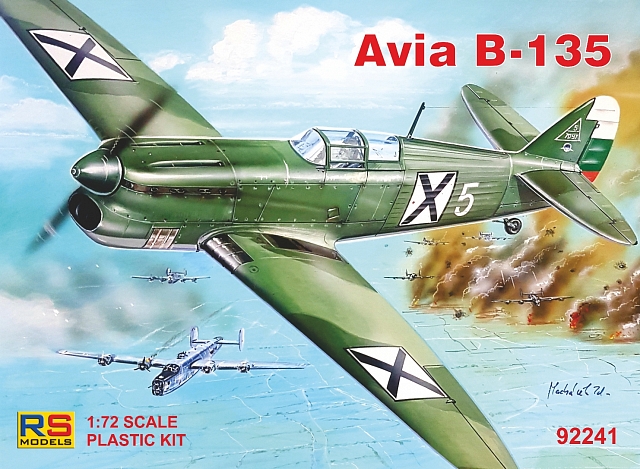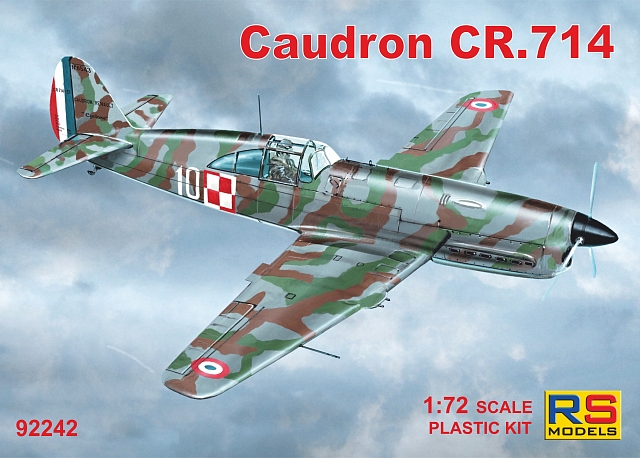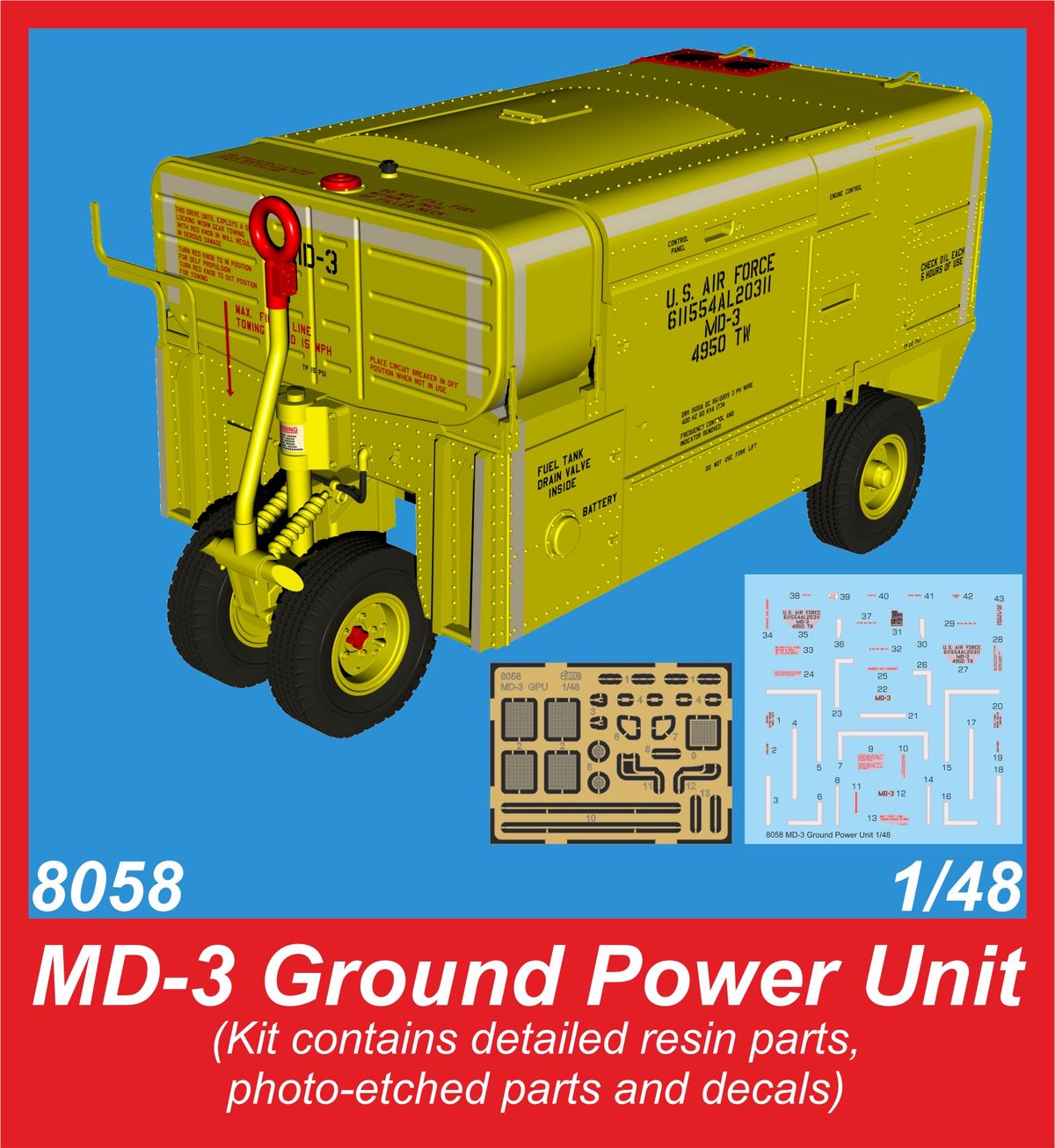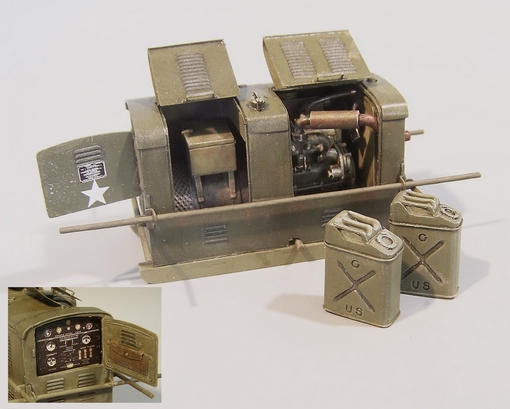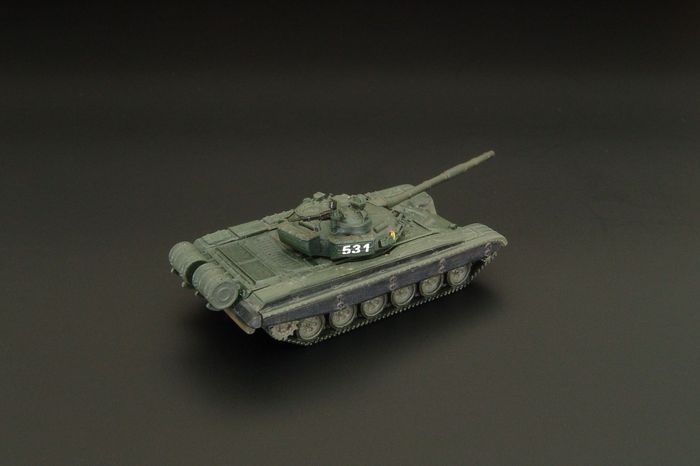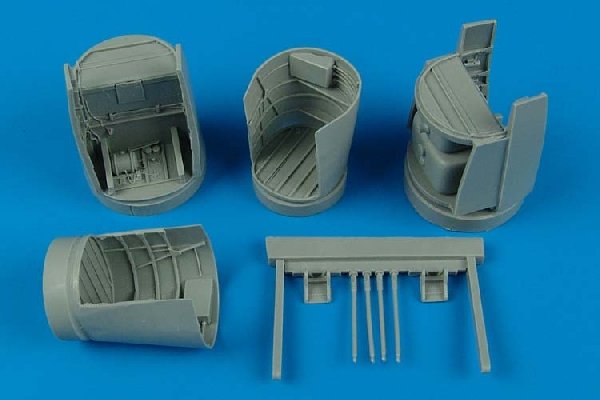Dětské zboží
Celkem 255 produktů
Plastikový model letadla 1/72 Caudron C-445/448 4 decal v. for France, Spain. Caudron C-455 was a conventionally configured low-wing cantilever monoplane with tailwheel undercarriage. The main undercarriage units retracted into the engine nacelles. Construction was wooden throughout, with wooden skinning everywhere but the forward and upper fuselage sections, which were skinned in metal. As usually configured, the cabin seated six passengers with baggage compartments fore and aft, and a toilet aft. 4 decal variants1. Caudron 448 Goéland, N°7272 F-AOMX, Course Paris-Saïgon, 1936 2. Caudron 445 Goéland, N°8712, GC I/55, France, June 1940 3. Caudron 445 Goéland, 2T-11, Mouzaiaville, Algeria, June 1944 4. Caudron 448 Goéland, N°7272, ex. F-AOMX, Grupo de Caza 26, 1937
Plastikový model letadla 1/72 Caudron C-445/448 4 decal v. for France, Spain. Caudron C-455 was a conventionally configured low-wing cantilever monoplane with tailwheel undercarriage. The main undercarriage units retracted into the engine nacelles. Construction was wooden throughout, with wooden skinning everywhere but the forward and upper fuselage sections, which were skinned in metal. As usually configured, the cabin seated six passengers with baggage compartments fore and aft, and a toilet aft. 4 decal variants1. Caudron 448 Goéland, N°7272 F-AOMX, Course Paris-Saïgon, 1936 2. Caudron 445 Goéland, N°8712, GC I/55, France, June 1940 3. Caudron 445 Goéland, 2T-11, Mouzaiaville, Algeria, June 1944 4. Caudron 448 Goéland, N°7272, ex. F-AOMX, Grupo de Caza 26, 1937
1/35 FMG 39 / FuSE 62 D Würzburg. Mobiles Funk-Messgerät / Flak-Messgerät / Funk-Sende-Empfangsgerät German WW2 Gun Laying Radar Product Details Highly detailed static plastic model Accurate details of D version Parabolic mirror foldable as in real Radar unit traversable and elevatable Finest bolt details Dipol DE 62 additional antennae included
1/35 FMG 39 / FuSE 62 D Würzburg. Mobiles Funk-Messgerät / Flak-Messgerät / Funk-Sende-Empfangsgerät German WW2 Gun Laying Radar Product Details Highly detailed static plastic model Accurate details of D version Parabolic mirror foldable as in real Radar unit traversable and elevatable Finest bolt details Dipol DE 62 additional antennae included
Plastikový model letadla 1/72 Avia B-135 3 decal v. for Luftwaffe, Bulgaria. 3 decal variants1. Avia B-135 - flown on 30th March, 1944 by Jordan Ferdinandov, Bulgaria2. Avia B-135 - FVA Flugtechnische Versuchsanstalt Prag, Letnany 19403. Avia B-135 - Aviation school Dolna Mitropolya, Bulgaria, 1944During the summer of 1939, ing. Novotný and his team initiated considerable re-design and refiment of the B.35, and a new prototype, the B-135, was completed late in the year. The fuselage of the B-135 was essentially similar to that of the B.35.3, the HS 12 Ycrs engine and armament of one 20 mm cannon and two 7,7 mm machine guns were retained, as was the hydraulically-recractable main undercarriage members of the B.35.3 prototype, but a controllable-pitchairscrew was introduced, the rudder was enlarged, and an entirely new wing of all-metal construction was fitted.
Plastikový model letadla 1/72 Caudron CR.714 C-1 4 decal v. for France, Luftwaffe, Finland. 4 decal variants1. Caudron CR-714, 2nd Esc. GC 1/145, Dreux, A. Niewiara, June 19402. Caudron CR-714, 1st Esc. GC 1/145, Villacoublay, L. Uher, May 19403. Caudron CR-714, Finland, May 19414. Caudron CR-714, test aicraft, Luftwaffe 1940The first prototype was test flown in July 1938 and the first production machine, powered by a Renault 12R-03, was delivered in July 1939. The armament consisted of four 7,5mm MAC 1934 machine guns located in two wing gondolas. Only GC 1-145 was equipped with the Caudron C.714. It was a unit composed of Polish pilots under French command. They fought against the Luftwaffe in spring 1940 and despite the aircraft climbing, the highly battle motivated Polish pilots scored 8 confirmed victories with an overall loss of 7 pilots. Until the fall of France, more than 60 machines were produced and several were in progress. At least one machine was tested by the Luftwaffe.
Plastikový model letadla 1/72 Caudron CR.714 C-1 4 decal v. for France, Luftwaffe, Finland. 4 decal variants1. Caudron CR-714, 2nd Esc. GC 1/145, Dreux, A. Niewiara, June 19402. Caudron CR-714, 1st Esc. GC 1/145, Villacoublay, L. Uher, May 19403. Caudron CR-714, Finland, May 19414. Caudron CR-714, test aicraft, Luftwaffe 1940The first prototype was test flown in July 1938 and the first production machine, powered by a Renault 12R-03, was delivered in July 1939. The armament consisted of four 7,5mm MAC 1934 machine guns located in two wing gondolas. Only GC 1-145 was equipped with the Caudron C.714. It was a unit composed of Polish pilots under French command. They fought against the Luftwaffe in spring 1940 and despite the aircraft climbing, the highly battle motivated Polish pilots scored 8 confirmed victories with an overall loss of 7 pilots. Until the fall of France, more than 60 machines were produced and several were in progress. At least one machine was tested by the Luftwaffe.
Plastikový model letadla 1/72 Avia B-135 3 decal v. for Luftwaffe, Bulgaria. 3 decal variants1. Avia B-135 - flown on 30th March, 1944 by Jordan Ferdinandov, Bulgaria2. Avia B-135 - FVA Flugtechnische Versuchsanstalt Prag, Letnany 19403. Avia B-135 - Aviation school Dolna Mitropolya, Bulgaria, 1944During the summer of 1939, ing. Novotný and his team initiated considerable re-design and refiment of the B.35, and a new prototype, the B-135, was completed late in the year. The fuselage of the B-135 was essentially similar to that of the B.35.3, the HS 12 Ycrs engine and armament of one 20 mm cannon and two 7,7 mm machine guns were retained, as was the hydraulically-recractable main undercarriage members of the B.35.3 prototype, but a controllable-pitchairscrew was introduced, the rudder was enlarged, and an entirely new wing of all-metal construction was fitted.
Plastikový model letadla 1/72 Avro Rota C.30A 4 decal v. for Czeczslovak.,RAF, Yugoslavia, Australia. The first production design in the series was the C.30, a radial-engined autogyro with a three-blade, 37 ft (11.3 m) rotor mounted on an aft-leaning tripod, the control column extending into the rear of the two cockpits. The engine was the five-cylinder, 105 hp (78 kW) Armstrong Siddeley Genet Major I used in the C.19 series. The fabric-covered fuselage carried an unbraced tailplane, without elevators but with turned-up tips. The port side of the tailplane had an inverted aerofoil section to counter roll-axis torque produced by the propeller. As with most autogyros, a high vertical tail was precluded by the sagging resting rotor, so the dorsal fin was long and low, extending well aft of the tailplane like a fixed rudder and augmented by a ventral fin. The wide-track undercarriage had a pair of single, wire-braced legs and a small tail wheel was fitted. This model flew in April 1933. It was followed by four improved machines designated C.30P (P here for pre-production) which differed in having a four-legged pyramid rotor mounting and a reinforced undercarriage with three struts per side. The rotor could be folded rearwards for transport. The C.30P used the more powerful (140 hp, 104 kW) seven-cylinder Armstrong Siddeley Genet Major IA radial engine.
Plastikový model letadla 1/72 Avro Rota C.30A 4 decal v. for Czeczslovak.,RAF, Yugoslavia, Australia. The first production design in the series was the C.30, a radial-engined autogyro with a three-blade, 37 ft (11.3 m) rotor mounted on an aft-leaning tripod, the control column extending into the rear of the two cockpits. The engine was the five-cylinder, 105 hp (78 kW) Armstrong Siddeley Genet Major I used in the C.19 series. The fabric-covered fuselage carried an unbraced tailplane, without elevators but with turned-up tips. The port side of the tailplane had an inverted aerofoil section to counter roll-axis torque produced by the propeller. As with most autogyros, a high vertical tail was precluded by the sagging resting rotor, so the dorsal fin was long and low, extending well aft of the tailplane like a fixed rudder and augmented by a ventral fin. The wide-track undercarriage had a pair of single, wire-braced legs and a small tail wheel was fitted. This model flew in April 1933. It was followed by four improved machines designated C.30P (P here for pre-production) which differed in having a four-legged pyramid rotor mounting and a reinforced undercarriage with three struts per side. The rotor could be folded rearwards for transport. The C.30P used the more powerful (140 hp, 104 kW) seven-cylinder Armstrong Siddeley Genet Major IA radial engine.
1/48 MD-3 Ground Power Unit. The MD-3 ground power unit was used throughout the 50s and 60s to generate electric power for starting up engines of such USAF aircraft as were the B-47, T-33 and many other with the same power requirements. The master parts of our kit have been 3D designed and produced on a 3D printer. The set also contains a PE fret and a sheet of decals. Operators: USA/modern
1/48 MD-3 Ground Power Unit. The MD-3 ground power unit was used throughout the 50s and 60s to generate electric power for starting up engines of such USAF aircraft as were the B-47, T-33 and many other with the same power requirements. The master parts of our kit have been 3D designed and produced on a 3D printer. The set also contains a PE fret and a sheet of decals. Operators: USA/modern
1/72 FM-2 Wildcat™ Training Cats Limited Edition. Stavebnice obsahuje plastové díly obtisky a 5 markingy Markingy: FM-2 Wildcat, U65, Carrier Aircraft Service Unit (CASU), MCAS Ewa, Hawaii 1944s FM-2 Wildcat, C50, training unit unnown, probably MCAS Florida, 1945 FM-2 Wildcat, LS03 (R), Unit unknown FM-2 Wildcat, NAMU3/1, Naval Air Modification Unit (NAMU), Johnsville, Pennsylvania, September 1946 FM-2 Wildcat, M-F 48, CVE-67, USS Solomons, US East Coast, May 1945
1/72 FM-2 Wildcat™ Training Cats Limited Edition. Stavebnice obsahuje plastové díly obtisky a 5 markingy Markingy: FM-2 Wildcat, U65, Carrier Aircraft Service Unit (CASU), MCAS Ewa, Hawaii 1944s FM-2 Wildcat, C50, training unit unnown, probably MCAS Florida, 1945 FM-2 Wildcat, LS03 (R), Unit unknown FM-2 Wildcat, NAMU3/1, Naval Air Modification Unit (NAMU), Johnsville, Pennsylvania, September 1946 FM-2 Wildcat, M-F 48, CVE-67, USS Solomons, US East Coast, May 1945
Classic Kit letadlo A02106 - De Havilland DH.82a Tiger Moth (1:72). Model letadla ke slepení. Velikost: 1:72; 10,2 cm. Balení obsahuje: 42 dílků ke slepení. Informace o originálu: Hlavní cvičný letoun De Havilland Tiger Moth, který je i dnes poměrně běžnou součástí vybavení leteckých základen po celém světě, absolvoval svůj první let už v roce 1931 a od té doby nepřestal zásobovat perutě leteckých složek Velké Británie a celého Commonwealthu tisícovkami vycvičených pilotů. Podobnou roli plní Tiger Moth dodnes a umožňuje aspirujícím pilotům „válečných ptáků“ získat cenné zkušenosti s létáním na letounech s ostruhovým kolem. Barevné schéma (Potřebné barvy): Barevné schéma 1: De Havilland DH.82a Tiger Moth Letecká stanice Královského námořnictva Abbotsinch, Paisley, Skotsko, 1962 Barevné schéma 2:De Havilland DH.82a Tiger Moth No,12 Local Air Supply Unit (LASU), letecká základna Kiarivu, Papua Nová Guinea, srpen 1945 Detaily modelu: Měřítko: 1:72 Počet dílů: 42 Délka: 102 mm Rozpětí křídel: 124 mm Obtížnost: 2 Body Flying Hours: 1 Doporučeno pro děti od 8 let. Upozornění: Nebezpečí udušení! Výrobek obsahuje malé části. NEVHODNÉ PRO DĚTI DO 3 LET!
Classic Kit letadlo A02106 - De Havilland DH.82a Tiger Moth (1:72). Model letadla ke slepení. Velikost: 1:72; 10,2 cm. Balení obsahuje: 42 dílků ke slepení. Informace o originálu: Hlavní cvičný letoun De Havilland Tiger Moth, který je i dnes poměrně běžnou součástí vybavení leteckých základen po celém světě, absolvoval svůj první let už v roce 1931 a od té doby nepřestal zásobovat perutě leteckých složek Velké Británie a celého Commonwealthu tisícovkami vycvičených pilotů. Podobnou roli plní Tiger Moth dodnes a umožňuje aspirujícím pilotům „válečných ptáků“ získat cenné zkušenosti s létáním na letounech s ostruhovým kolem. Barevné schéma (Potřebné barvy): Barevné schéma 1: De Havilland DH.82a Tiger Moth Letecká stanice Královského námořnictva Abbotsinch, Paisley, Skotsko, 1962 Barevné schéma 2:De Havilland DH.82a Tiger Moth No,12 Local Air Supply Unit (LASU), letecká základna Kiarivu, Papua Nová Guinea, srpen 1945 Detaily modelu: Měřítko: 1:72 Počet dílů: 42 Délka: 102 mm Rozpětí křídel: 124 mm Obtížnost: 2 Body Flying Hours: 1 Doporučeno pro děti od 8 let. Upozornění: Nebezpečí udušení! Výrobek obsahuje malé části. NEVHODNÉ PRO DĚTI DO 3 LET!
1/72 Curtiss H-75N Hawk Royal Thai Air Force 1941-1944. 1/72 Curtiss H-75N Hawk Royal Thai Air Force 1941-1944. Obsahuje 4 markingy. - Curtiss H75N-5, first Curtiss will deliverThailand , Don Muang 1941, Bankok, Royal Thai Air Force - Curtiss H75N-5, 16. Squadron, 95. Wing, Don Muang 1941, Royal Thai Air Force - Curtiss H75N-5, 60. Squadron, fighter Unit Pak-Tai, Udon airfield, Royal Thai Air Force 1941 - Curtiss H75N-5,43. Squadron, 85. Wing, Don Muang 1944, Royal Thai Air Force.
1/48 Curtiss H-75N Royal Thai Air Force service 1941-1944. 1/48 Curtiss H-75N Thajské Královské letectvo 1941-1944. Obsahuje 4 markingy: - Curtiss H-75N-5, first Curtiss will deliver Thailand, Don Muang 1941, Bangkok, Royal Thai Air Force - Curtiss H-75N-5, 16. Squadron, 95. Wing, Don Muang 1941, Royal Thai Air Force - Curtiss H-75N-5, 60. Squadron, fighter Unit Pak-Tai, Udon airfield, Royal Thai Air Force 1941 - Curtiss H-75N-5, 43. Squadron, 85. Wing, Don Muang 1944, Royal Thai Air Force



